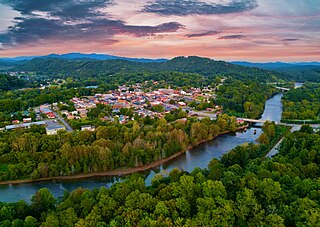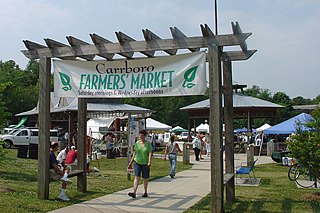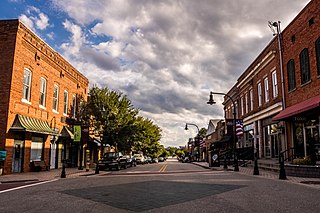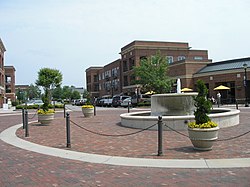
Chapel Hill is a town in Orange and Durham Counties North Carolina, United States. Its population was 61,960 in the 2020 census, making Chapel Hill the 17th-most populous municipality in the state. Chapel Hill and Durham make up the Durham-Chapel Hill, NC Metropolitan Statistical Area, which had an estimated population of 608,879 in 2023. When it's combined with Raleigh, the state capital, they make up the corners of the Research Triangle, which had an estimated population of 2,368,947 in 2023.

The University of North Carolina at Chapel Hill is a public research university in Chapel Hill, North Carolina, United States. Chartered in 1789, the university first began enrolling students in 1795, making it one of the oldest public universities in the United States.

Murphy is a town in and the county seat of Cherokee County, North Carolina, United States. It is situated at the confluence of the Hiwassee and Valley rivers. It is the westernmost county seat in the state of North Carolina, approximately 360 miles (580 km) from the state capital in Raleigh. The population of Murphy was 1,608 at the 2020 census.

Carrboro is a town in Orange County in the U.S. state of North Carolina. The population was 21,295 at the 2020 census. The town, which is part of the Raleigh-Durham-Chapel Hill combined statistical area, was named after North Carolina industrialist Julian S. Carr.

Wake Forest is a town in Wake and Franklin counties in the U.S. state of North Carolina. Located almost entirely in Wake County, it lies just north of the state capital, Raleigh. At the 2020 census, the population was 47,601, up from 30,117 in 2010. It is part of the Raleigh metropolitan area. Wake Forest was the original home of Wake Forest University for 122 years before it moved to Winston-Salem in 1956.

Cary is a town in Wake, Chatham, and Durham counties in the U.S. state of North Carolina and is part of the Raleigh-Cary, NC Metropolitan Statistical Area. According to the 2020 census, its population was 174,721, making it the seventh-most populous municipality in North Carolina, and the 148th-most populous in the United States. In 2023, the town's population had increased to 180,010.

Haddenham is a village and civil parish in west Buckinghamshire, England. It is about 5 miles (8 km) south-west of Aylesbury and 4 miles (6 km) north-east of Thame in neighbouring Oxfordshire. At the 2011 Census, the population of the civil parish was 4,502.

Bynum is an unincorporated community in northeastern Chatham County, North Carolina, United States on the banks of the Haw River. Bynum is five miles (8.0 km) north of Pittsboro and eleven miles (18 km) south of Chapel Hill. It is also known as Bynum Mill Village or Bynum Mill Hill.
The Penland School of Craft is an Arts and Crafts educational center located in the Blue Ridge Mountains in Penland, North Carolina in the Snow Creek Township near Spruce Pine, about 50 miles from Asheville.

Carr Mill Mall is a small, local shopping mall located in Carrboro, North Carolina. It is listed on the National Register of Historic Places as the Alberta Mill Complex. It is also a host for numerous local live performances and other cultural events.

The Orton Plantation is a historic plantation house in the Smithville Township of Brunswick County, North Carolina, United States. Located beside the Cape Fear River between Wilmington and Southport, Orton Plantation is considered to be a near-perfect example of Southern antebellum architecture. Built in 1735 by the co-founder of Brunswick Town, Colonel Maurice Moore, the Orton Plantation house is one of the oldest structures in Brunswick County. During its history Orton Plantation has been attacked by Native Americans, used as a military hospital, and been home to lawyers, physicians, military leaders, and a Colonial governor.

St. Philips Episcopal Church, also known as St. Philips Church, is a historic Episcopal church located on NC 65 and 8 and SR 1957 in Germanton, Stokes County, North Carolina. It was built in 1890, consecrated in 1894, and is a one-story, Gothic Revival style board-and-batten frame building. It features a two-stage corner tower and belfry.

The DuBose Conference Center, formally known as the DuBose Memorial Church Training School, is a historic site and former conference center associated with the Episcopal Church at Fairmont and College Streets in Monteagle, Tennessee. It was historically an Episcopal Church training and conference center. On April 29, 2023, the conference center permanently ceased operations when the Episcopal Diocese of Tennessee deconsecrated the property. The mission of DuBose Conference Center was to "offer hospitality, programming, and sacred space to groups of all faiths and backgrounds for education, creativity, and renewal."

Richard Sharp Smith was an English-born American architect, noted for his association with George W. Vanderbilt's Biltmore Estate and Asheville, North Carolina. Smith worked for some of America's important architectural firms of the late 19th century—Richard Morris Hunt, Bradford Lee Gilbert, and Reid & Reid—before establishing his practice in Asheville. His most significant body of work is in Asheville and Western North Carolina, including dozens of buildings that are listed on the National Register of Historic Places or are contributing structures to National Register Historic Districts.

The Crabtree Jones House, also known historically as the Nathaniel Jones Jr. House, is a residence at 3108 Hillmer Drive in Raleigh, North Carolina. Constructed around 1808-1811 by Nathaniel Jones, it is one of the few remaining large scale plantation homes in Wake County, and one of the oldest private residences in Raleigh. The home has received several additions since its initial construction, but is mainly known for its Federal-style front. Owned by the Jones family for more than 150 years, the house has fallen into disrepair in more recent decades. Following the purchase of the land the house sat upon by developers in 2012, Preservation North Carolina acquired the house and had it moved to a nearby residential neighborhood, where it sits today. The Crabtree Jones house was greatly influenced by the historical events it stood through while in turn influencing the way the Raleigh community developed around it, through both its people and through its land.
Crossnore School Historic District is a historic school campus and national historic district located at Crossnore, Avery County, North Carolina. It encompasses four contributing buildings and one contributing structure and are the oldest surviving buildings associated with the school established here in 1913. The buildings were built between 1928 and 1960, and constructed of stone, frame, or log construction, and stand 1+1⁄2 or 2 stories in height. They are the Daughters of the American Revolution Dormitory / Cooper Building, E.H. Sloop Chapel (1956), DAR Chapter House (1958-1959), Garrett Memorial Hospital / Edwin Guy Building, bell tower, and the separately listed Weaving Room of Crossnore School.

Young Men's Institute Building, also known as the YMI Building, is a historic meeting hall located at Asheville, Buncombe County, North Carolina. It was designed by architect Richard Sharp Smith and built in 1892–1893. It is a 2+1⁄2-story, pebbledash coated masonry building with brick, stone, and wood accents. From its early days, the YMI building has housed shops, residence rooms, meeting rooms, and a wide variety of functions serving the African American community of Asheville. The building was restored and reestablished as the YMI Cultural Center in 1980, and now hosts a variety of intercultural programs and events. It is located in the Downtown Asheville Historic District.

The Wilkins House is a historic house in Greenville, South Carolina, built in 1878 by Jacob W. Cagle (1832–1910) for merchant and capitalist William T. Wilkins (1825–1895). It was listed on the National Register of Historic Places on July 19, 2016.

Beta Theta Pi Fraternity House, also known as the Eta chapter of Beta Theta Pi, is a historic fraternity house located at Chapel Hill, Orange County, North Carolina. The fraternity house was listed on the National Register of Historic Places on April 20, 2005.

The Arthur C. and Mary S.A. Nash House is a historic home in Chapel Hill, North Carolina, located at 124 South Boundary Street.























